Tuesday, July 5. 2005
Eagle Cam Looked at those babies lately? You click above to switch from the Eagle Cam to the Osprey Cam.
Tuesday, June 28. 2005
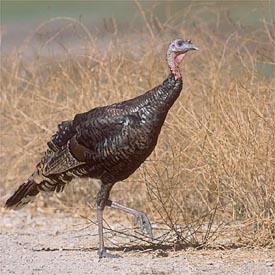
A huge wildlife management success story - the reintroduction of the Wild Turkey into the areas in which it had been eliminated (by extensive farming, combined with the 1904 chestnut blight). This giant, ever-watchful game bird is now back in huntable numbers in forested areas across the US, even in suburbia. And with its return, we see the return of the cult of the ancient Indian turkey-hunting techniques. Everybody says they see them all the time, so they should be easy to hunt, but have you ever seen one within 20 yards when you were in camo, sitting under a tree with a shotgun in your hand, at 6 AM? I haven't. Ben Franklin wanted this guy to be on the National Seal, not the fish-thieving Bald Eagle. And, by the way, this is not the ancestor of the domestic turkey - that ancestor is the white-tailed wild turkey of Central America. Read more about this dramatic bird.
Friday, June 24. 2005
Whaleburgers Aw, man, gee whiz, can you Japanese give the whales a break? What is it about the Japanese and whales? They taste like beef? So eat beef. We will never run out of cows.
Monday, June 20. 2005
Red Tide The worst red tide in memory has hit the New England coast this spring, from Maine to Nantucket, slamming Cape Cod and Cape Cod Bay. This nasty algae bloom renders mollusks toxic, so it's a disaster for the shellfishers as well as for the shellfish-eaters. Thus far, it has not moved south into Rhode Island. Details in Boston Globe. Basics on algal blooms here.
Monday, June 13. 2005
 The Wild Salmon Problem The Wild Salmon Problem
How do you solve this one? The dams in the Columbia River system provide cheap power but destroy the wild salmon. The farm-raised salmon, cheaper than 10 years ago, is great stuff, but how do you balance economics and conservation? These require Solomonic, or should I say, Salmonic, decisions.
Wednesday, June 8. 2005
 A nationwide, usually flocking songbird with a subtle, creamy color. Not uncommon, especially where fruits and berries are abundant. Read more about this attractive bird. A nationwide, usually flocking songbird with a subtle, creamy color. Not uncommon, especially where fruits and berries are abundant. Read more about this attractive bird.
Photo courtesy of Bill Horn - his link to the left.
Tuesday, June 7. 2005
 Lynx in Minnesota: Lynx in Minnesota: This is good news. A wonderful critter.
Saturday, June 4. 2005
 Pardon this poor photo of this wonderfully-colored bird which is common in the eastern woodlands and edges, and in suburbia, with its masterfully-woven hanging nests and its loud call which announces its presence. Pardon this poor photo of this wonderfully-colored bird which is common in the eastern woodlands and edges, and in suburbia, with its masterfully-woven hanging nests and its loud call which announces its presence.
We must have seen a dozen of them last weekend in New Haven. Like the tanager, it looks like a jungle bird and, indeed, during our winter, it is. Read about this splendid bird here.
Wednesday, June 1. 2005
 It's hard to imagine that in 1972 this large fish-catching water bird was named a species "of special concern" by the Audubon Society. It's numbers have rocketed since the banning of DDT. It's hard to imagine that in 1972 this large fish-catching water bird was named a species "of special concern" by the Audubon Society. It's numbers have rocketed since the banning of DDT.
Like their cousin Anhingas in the Everglades, they are often seen drying their feathers on rocks and buoys, with wings outstretched. They swim very low in the water - often only their neck and head are visible - and pursue fish underwater. It has a wide breeding range, both coastal and inland, but instead of welcoming its resurgence, in some areas it is being killed as a competitor to recreational fishing. All animals beware: when it's dollars vs. you, watch out! Read more about this unusual bird here. Photo courtesy of Bill Horn - his bird photography link to the left.
Monday, May 30. 2005
Despite being the end of migration, and despite the leaves being fully unfurled, we were able to find a few good birds Sunday morning in the expansive and lovely East Rock P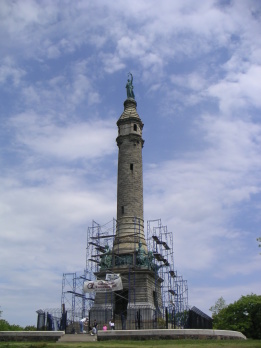 ark in New Haven: ark in New Haven: Black and White Warbler
Blackburnian Warbler
Canada Warbler
Magnolia Warbler
Common Yellowthroat
Yellow Warbler
Redstart
Red-Eyed Vireo
Warbling Vireo
Solitary Vireo
Philadelphia Vireo
Baltimore Oriole
Wood Pewee
Yellow-Billed Cuckoo
Red Bellied Woodpecker
Rough-winged Swallow
Red Tailed Hawk
Turkey Vulture
Black Crowned Night Heron
Wood Thrush
Scarlet Tanager Plus of course the regular stuff. Always good to see woodland robins - we think of them as suburban lawn birds but they aren't - they are woodland thrushes which found our suburban lawns to be an easy source of earthworms. Thanks to Ron Bell, the great Connecticut ornithologist, for joining us yesterday for the final warbler outing of the year, and thanks to M and J for their auditory skills. The Phila. Vireo was a first for the Bird Dog. My photo of New Haven's Soldier's and Sailor's Monument, which overlooks New Haven and Long Island Sound from its perch on the peak of East Rock. God Bless both our eager and reluctant warriors, who give us the freedom we thrive on.
Saturday, May 28. 2005
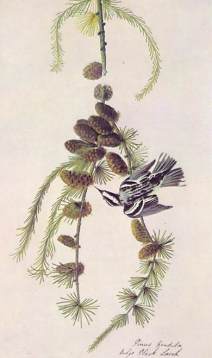 What a fine, simple name for a bird. It is now the end of warbler migration, and migration in general. This common warbler, pictured here in a Larch (remember "The Larch" on Monty Python?), is beginning to nest, although it's still cold this week up here. Read more about this handsome warbler., which is seen in the eastern 2/3 of the US.
Thursday, May 19. 2005
By this time of year, the fairly common Goldfinch has 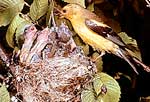 undergone the spring undergone the spring
molt and the canary-yellow males become much more evident. In the winter, they are a drab shade of olive. They are usually seen in small flocks in weedy fields and edges. If you don't think you have Goldfinches in your area, put out a thistle feeder for a few weeks. Read more about the American Goldfinch.
Thursday, May 12. 2005
Email from a Friend in CT Yesterday Bird Dog: Sitting on my back deck this AM stuffing envelopes for Ducks Unlimited with my ears wide open. Here's what I am hearing: red-eyed vireo, black and white warbler, chestnut-sided warbler, baltimore oriole, cape may warbler, parula warbler. All singing just for me! CF
Parula Warbler A common eastern tree-top migrant, more often identified by voice than by eye. Nice looking tiny bird, though. Northern variety likes to nest in dead man's beard, southern version in Spanish moss. Read more about this warbler.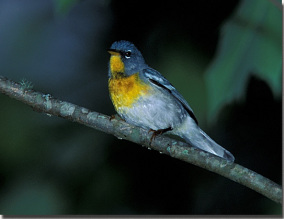
Wednesday, May 11. 2005
Gorilla Warfare: War over gorillas in Africa., from NYT. The Sky may not be Falling: We understand the hidden motive of "Smash Capitalism to Save the Earth," but what if the earth is sort-of OK?
Thursday, May 5. 2005
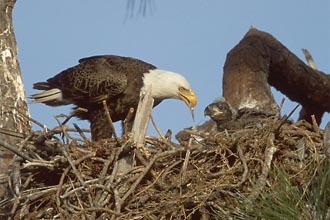 Peregrines, Ospreys and Eagles Peregrines, Ospreys and Eagles
Seen their videocams lately? The chicks are growing. NYC Peregrine. Maryland Osprey. Maryland Eagles. What's that corncob doing in the nest on the video? Looks like they had a clambake up there. Also, the story of the removal of one of the eaglets to Vermont. Photo courtesy of P. LaTourette - his link to the left.
Sunday, May 1. 2005
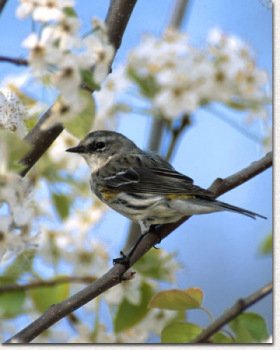 As the buds pop now in New England, we are in warbler season - one of the birder's high-points of the year. Odd factoid - New York's Central Park is one of the best locations for migrants in the US - and I mean bird migrants. And one of the best spots for odd species - and I mean odd bird species. The Yellow-rumped is another abundant migrant, but unique as a warbler that can winter in the north, living on bayberries which they have a unique ability to digest. We used to call them Myrtle Warblers - some of us still do. Bright yellow at base of tail is diagnostic. Found across the US and Canada. Click here: All About Birds Photo courtesy of Bill Horn.
Friday, April 29. 2005
Video of Ivory Bill If you aren't into God's nature, you don't understand what a big deal this is. We posted the news yesterday AM. For the video - Click here: http://news.nationalgeographic.com/news/video/qt/woodpecker.mov Of course, Scrapple-Man has to put in his two cents.
Thursday, April 28. 2005
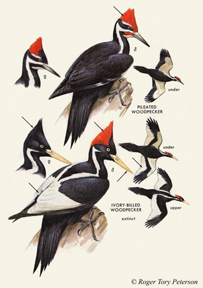 Bird of the Year Bird of the Year
For birders, a VERY BIG DEAL, and very heartening. The Ivory-bill, long believed extinct, likes the swamps of the deep south. The definite ID of one on the Arkansas border with La. is wonderful. Story here
Tuesday, April 26. 2005
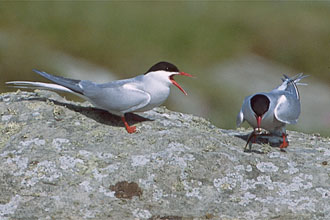 Along the New England coast, we have mainly Common Terns, some Least Terns, some Roseate and some Forster's Terns if you can ID them, and some Arctic Terns passing through. Along the New England coast, we have mainly Common Terns, some Least Terns, some Roseate and some Forster's Terns if you can ID them, and some Arctic Terns passing through.
Tough to ID them, but their white secondaries are field-marks, plus their blood-red bill. These birds, like Peregrine Falcons, are the great travellers of the world, wintering in Antarctica and breeding in the Arctic. A 25,000-mile migration. I haven't seen one in years, but haven't looked for one either. Have seen them on Cape Cod, taking a rest on their way south. Not too much known about these fine minnow-munchers, but read more here. Photo courtesy of P. LaTourette.
Thursday, April 21. 2005
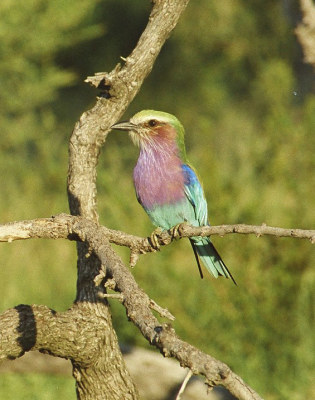 Never seen in New England! And never will be. Never seen in New England! And never will be.
This Lilac-Breasted Roller, also known as the Rainbow Bird, photographed by Matt Grimes on the Savuti Channel in Botswana last month. Bird photography is tough. Just try it. This is a very fine shot.
Monday, April 18. 2005
A rarity in New England, Julian took this photo on Saturday in Deep River, CT. First record in 20 years. A hell of a photo. This bird is lost - they tend to be Fla. breeders, but are mainly South American birds. Read more about this beautiful  hawk here. hawk here.
Tuesday, April 12. 2005
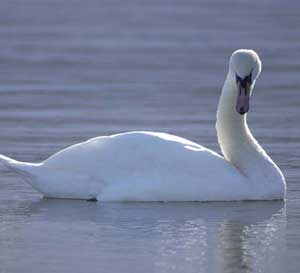 Romantic and graceful, the Mute Swan is an elegant but unwelcome pest in areas of the country, such as southern New England, where it thrives. Romantic and graceful, the Mute Swan is an elegant but unwelcome pest in areas of the country, such as southern New England, where it thrives.
Originally introduced from Europe to ornament ponds on the estates of the wealthy, they are highly aggressive towards our native waterfowl, and turn vegetated bottoms into bare mud. They are reputed to be delicious to eat, and there are efforts to control their populations in areas where their numbers are destructive. Mute Swan's orange or yellow bill distinguishes it easily from North America's two native swans, the Tundra Swan and the Trumpeter Swan. Plus the fact that it is mute. Read more: Click here: All About Birds
Friday, April 8. 2005
 Eaglets Eaglets
3 chicks at Blackwater - too bad it's the reloading type of live video: here More info on the chicks here. One of them might be taking a trip to Vermont to help restore populations up there. Photo courtesy of P. LaTourette - his link to left.
Thursday, March 31. 2005
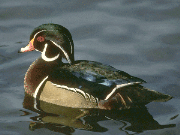 The male Wood Duck is the most flamboyant and exotic looking bird in North America. They have just returned here, where I live - saw a few on Sunday afternoon. It's getting late to put out nest boxes, but not too late quite yet. Assuming you have water - streams or ponds or marshy lakes. Their growing population relies on human intervention, because dopey humans cut down the dead trees they like to nest in. The male Wood Duck is the most flamboyant and exotic looking bird in North America. They have just returned here, where I live - saw a few on Sunday afternoon. It's getting late to put out nest boxes, but not too late quite yet. Assuming you have water - streams or ponds or marshy lakes. Their growing population relies on human intervention, because dopey humans cut down the dead trees they like to nest in.
Build duck nest boxes: Click here: Wood Duck . Buy them: Click here: Duck Houses at BestNest.com! and learn about "Woodies": Click here: All About Birds
|
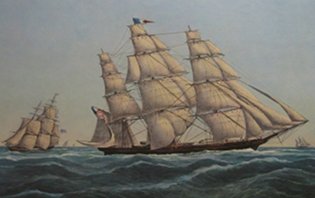


 The Wild Salmon Problem
The Wild Salmon Problem A nationwide, usually flocking songbird with a subtle, creamy color. Not uncommon, especially where fruits and berries are abundant. Read more about this attractive
A nationwide, usually flocking songbird with a subtle, creamy color. Not uncommon, especially where fruits and berries are abundant. Read more about this attractive  Lynx in Minnesota: This is good
Lynx in Minnesota: This is good  Pardon this poor photo of this wonderfully-colored bird which is common in the eastern woodlands and edges, and in suburbia, with its masterfully-woven hanging nests and its loud call which announces its presence.
Pardon this poor photo of this wonderfully-colored bird which is common in the eastern woodlands and edges, and in suburbia, with its masterfully-woven hanging nests and its loud call which announces its presence. It's hard to imagine that in 1972 this large fish-catching water bird was named a species "of special concern" by the Audubon Society. It's numbers have rocketed since the banning of DDT.
It's hard to imagine that in 1972 this large fish-catching water bird was named a species "of special concern" by the Audubon Society. It's numbers have rocketed since the banning of DDT.  ark in New Haven:
ark in New Haven:
 undergone the spring
undergone the spring 
 Peregrines, Ospreys and Eagles
Peregrines, Ospreys and Eagles As the buds pop now in New England, we are in warbler season - one of the birder's high-points of the year. Odd factoid - New York's Central Park is one of the best locations for migrants in the US - and I mean bird migrants. And one of the best spots for odd species - and I mean odd bird species.
As the buds pop now in New England, we are in warbler season - one of the birder's high-points of the year. Odd factoid - New York's Central Park is one of the best locations for migrants in the US - and I mean bird migrants. And one of the best spots for odd species - and I mean odd bird species. Bird of the Year
Bird of the Year Along the New England coast, we have mainly Common Terns, some Least Terns, some Roseate and some Forster's Terns if you can ID them, and some Arctic Terns passing through.
Along the New England coast, we have mainly Common Terns, some Least Terns, some Roseate and some Forster's Terns if you can ID them, and some Arctic Terns passing through. Never seen in New England! And never will be.
Never seen in New England! And never will be. hawk
hawk  Romantic and graceful, the Mute Swan is an elegant but unwelcome pest in areas of the country, such as southern New England, where it thrives.
Romantic and graceful, the Mute Swan is an elegant but unwelcome pest in areas of the country, such as southern New England, where it thrives. The male Wood Duck is the most flamboyant and exotic looking bird in North America. They have just returned here, where I live - saw a few on Sunday afternoon. It's getting late to put out nest boxes, but not too late quite yet. Assuming you have water - streams or ponds or marshy lakes. Their growing population relies on human intervention, because dopey humans cut down the dead trees they like to nest in.
The male Wood Duck is the most flamboyant and exotic looking bird in North America. They have just returned here, where I live - saw a few on Sunday afternoon. It's getting late to put out nest boxes, but not too late quite yet. Assuming you have water - streams or ponds or marshy lakes. Their growing population relies on human intervention, because dopey humans cut down the dead trees they like to nest in.